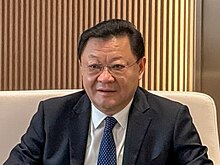Wang Weizhong (Chinese: 王伟中; born March 1962) is a Chinese politician currently serving as deputy party secretary and governor of Guangdong. A graduate of Tsinghua University, Wang rose through the ranks working for the Ministry of Science and Technology. He previously served as party chief of Taiyuan.
Wang Weizhong | |||||||||||||
|---|---|---|---|---|---|---|---|---|---|---|---|---|---|
王伟中 | |||||||||||||
 Wang in 2024 | |||||||||||||
| Governor of Guangdong | |||||||||||||
| Assumed office 27 December 2021 | |||||||||||||
| Secretary | Li Xi Huang Kunming | ||||||||||||
| Preceded by | Ma Xingrui | ||||||||||||
| Specifically-designated Deputy Communist Party Secretary of Guangdong | |||||||||||||
| In office 14 December 2018 – 24 December 2021 | |||||||||||||
| Secretary | Li Xi | ||||||||||||
| Preceded by | Ren Xuefeng | ||||||||||||
| Succeeded by | Meng Fanli | ||||||||||||
| Communist Party Secretary of Shenzhen | |||||||||||||
| In office March 2017 – December 2021 | |||||||||||||
| Preceded by | Xu Qin | ||||||||||||
| Communist Party Secretary of Taiyuan | |||||||||||||
| In office November 2016 – March 2017 | |||||||||||||
| Preceded by | Wu Zhenglong | ||||||||||||
| Succeeded by | Luo Qingyu | ||||||||||||
| Personal details | |||||||||||||
| Born | March 1962 (age 62) Shuozhou, Shanxi, China | ||||||||||||
| Political party | Chinese Communist Party | ||||||||||||
| Alma mater | Tsinghua University | ||||||||||||
| Profession | Water Resources Engineer | ||||||||||||
| Chinese name | |||||||||||||
| Simplified Chinese | 王伟中 | ||||||||||||
| Traditional Chinese | 王偉中 | ||||||||||||
| |||||||||||||
Biography
editWang is a native of Shuozhou, Shanxi province. In September 1984, he graduated from the department of hydraulic engineering at Tsinghua University. In April 1987, he earned a master's degree. He spent much of the next decade working for the ministry overseeing water resources. In August 1991 he was transferred to the National Science Commission (the later Ministry of Science and Technology) to work on matters related to the environment.[citation needed]
In August 1994, Wang entered the ecology division of the National Science Commission. In July 1998, he was made head of the China 21st Century Agenda Management Center (中国21世纪议程管理中心) and the head of the Life Science Technology Development Center. In March 2006, he was named head of the finance department at the Ministry of Science and Technology. In April 2010, he was promoted to Vice Minister of Science and Technology.[1][2]
In September 2014, Wang was 'parachuted' to his home province Shanxi to handle the clean-up of the political scene after many senior level politicians had been placed under investigation as part of the anti-corruption campaign under Xi Jinping. He was first named secretary-general of the party organization and a member of the provincial party standing committee.[3] In October 2016, Wang was named Chinese Communist Party Committee Secretary of Taiyuan, the provincial capital.[4]
In April 2017, Wang was named a member of the Guangdong provincial standing committee and party chief of Shenzhen.[5]
On December 14, 2018, Wang rose to become deputy party secretary of Guangdong.[6] In December 2021, he became governor of Guangdong, replacing Ma Xingrui.[7]
In October 2022, he became a member of the 20th Central Committee of the Chinese Communist Party.[8][9]
References
edit- ^ 国务院任免国家工作人员 王伟中为科技部副部长. people.com.cn. Retrieved 2013-12-12.
- ^ 科技部副部长王伟中:五方面促进科技与金融结合. Ifeng. Retrieved 2013-12-12.
- ^ 王伟中任山西省委秘书长 曾任科技部副部长
- ^ 王伟中任山西太原市委书记,吴政隆另有任用. thepaper.cn. Retrieved 2016-10-12.
- ^ 太原市委书记王伟中调任深圳市委书记,许勤不再担任. thepaper.cn. Retrieved 2017-04-04.
- ^ 深圳市委书记王伟中任广东省副书记 [Wang Weizhong, Communist Party Secretary of Shenzhen, is appointed Deputy Communist Party Secretary of Guangdong]. 163.com (in Chinese). 2018-12-04.
- ^ Yi Yi (伊一) (27 December 2021). 王伟中代理广东省省长 马兴瑞辞去省长职务. ce.cn (in Chinese). Retrieved 28 December 2021.
- ^ Lin Yunshi (林韵诗) (12 October 2022). 十九届七中全会闭幕 三人递补为中央委员. caixin.com (in Chinese). Retrieved 13 October 2022.
- ^ "(CPC Congress) List of members of 20th CPC Central Committee-Xinhua". english.news.cn. Retrieved 2022-12-14.